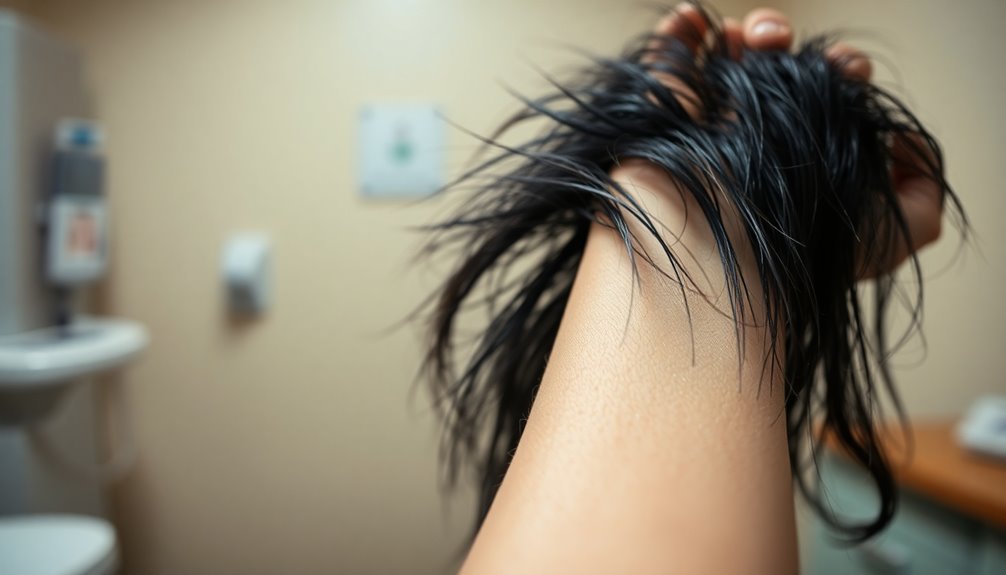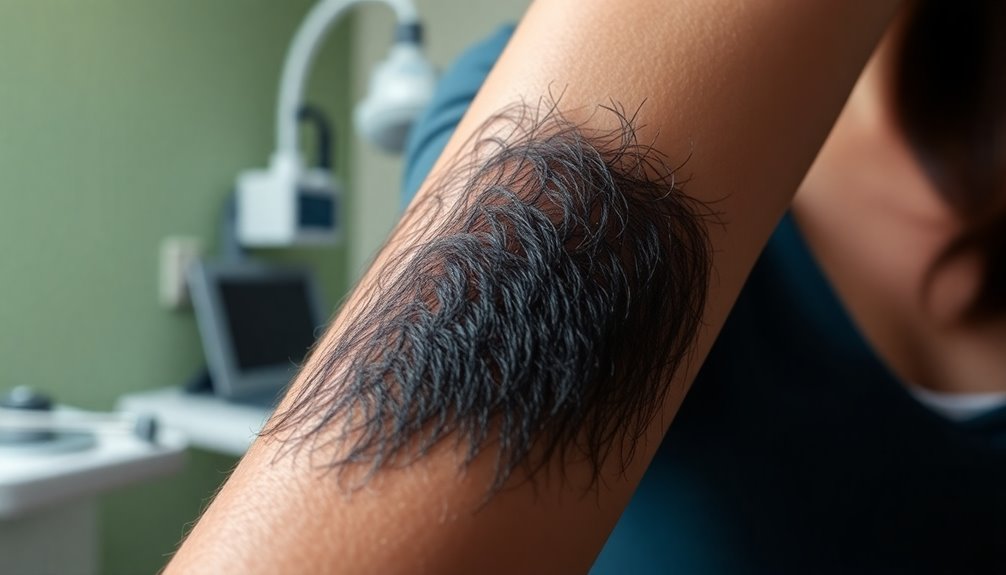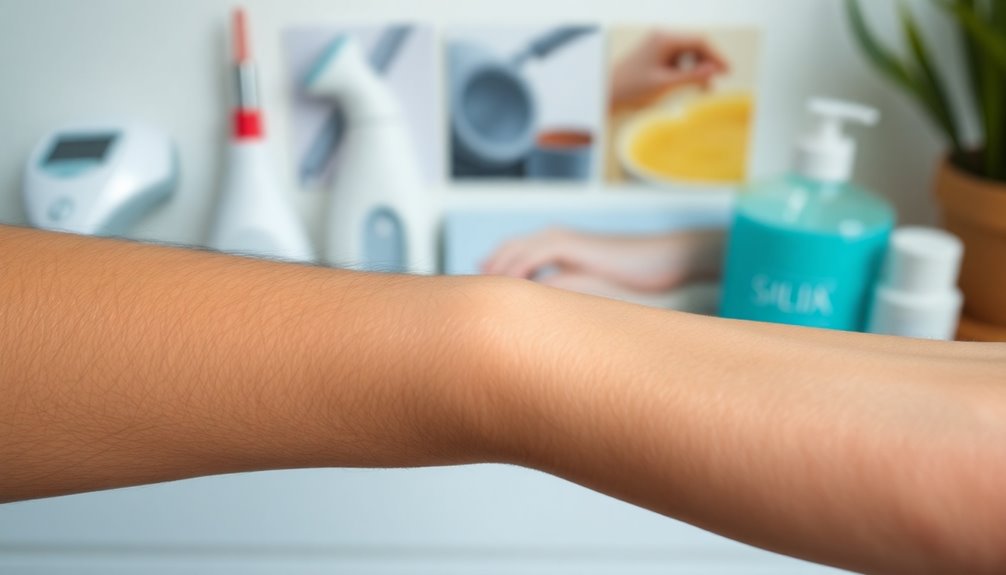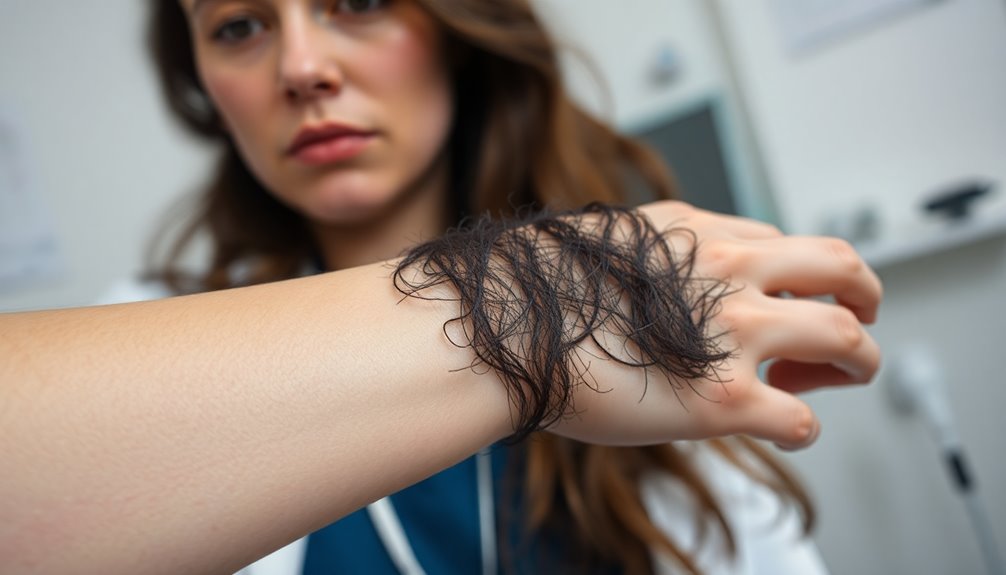You might be shocked to learn that excessive hair growth in women, known as hirsutism, can affect 5-10% of women, often linked to hormonal imbalances like PCOS. It causes dark, coarse hair growth in areas typically seen in men, such as the face and chest. Symptoms may also include acne and irregular periods, resulting in emotional distress. Understanding the causes and treatment options is essential, and there's much more to explore about managing this condition effectively.
Key Takeaways
- Hirsutism causes excessive hair growth in women, often in male-pattern areas like the face and chest, due to elevated androgen levels.
- Polycystic Ovary Syndrome (PCOS) is a leading cause, affecting 70% to 80% of women diagnosed with hirsutism.
- Symptoms include dark, coarse hair growth, acne, irregular menstrual cycles, and emotional distress from social embarrassment.
- Treatment options range from hormonal medications, weight management, to hair removal methods like electrolysis and laser therapy.
- Lifestyle changes, such as a balanced diet and regular exercise, can significantly help in managing symptoms and hormone levels.
What Is Hirsutism?

Hirsutism, which refers to the excessive growth of dark or coarse hair in women, often appears in areas typically associated with male hair patterns, like the face, chest, and back. This condition is primarily driven by elevated levels of androgens, particularly testosterone.
Many women with hirsutism may also have polycystic ovary syndrome (PCOS), affecting about 70% to 80% of those diagnosed. Alongside excessive hair growth, symptoms can include deepening voice, acne, and irregular menstrual cycles.
To diagnose hirsutism, healthcare providers typically conduct a physical examination and hormone level blood tests.
Treatment options range from lifestyle changes to medications like birth control pills and anti-androgens, along with various hair removal methods for long-term management.
Common Symptoms of Hirsutism

Excessive hair growth can be one of the most noticeable signs of hirsutism, affecting areas like the face, chest, and back.
You might also experience symptoms of virilization, including a deepening voice, increased muscle mass, balding, or decreased breast size. The severity of these symptoms can vary; some women notice gradual changes, while others see sudden, striking differences.
Many of these symptoms stem from elevated male hormones (androgens), often linked to Polycystic Ovary Syndrome (PCOS), which affects 70% to 80% of women with this condition.
Elevated male hormones, or androgens, are often associated with Polycystic Ovary Syndrome, impacting 70% to 80% of affected women.
Unfortunately, the physical signs of hirsutism can lead to emotional distress, anxiety, and social embarrassment, greatly impacting your quality of life.
Recognizing these symptoms is essential for seeking the right support and treatment.
Causes Behind Excessive Hair Growth

Understanding the causes behind excessive hair growth is essential for addressing the issue effectively.
Hormonal imbalances, genetic predispositions, and certain medications can all play a significant role in hirsutism.
Let's explore each of these factors to see how they might affect you.
Hormonal Imbalances Explained
When hormonal imbalances occur, particularly with elevated androgen levels like testosterone, women may experience excessive hair growth in areas typically associated with male-pattern hair distribution.
This condition, known as hirsutism, can be linked to several factors:
- Polycystic Ovary Syndrome (PCOS): A common hormonal disorder affecting 5% to 10% of women.
- Cushing syndrome: High cortisol levels can disrupt hormonal balance.
- Congenital adrenal hyperplasia: Enzyme deficiencies affecting steroid hormone production.
- Medications: Anabolic steroids and corticosteroids can increase androgen levels.
- Genetic predisposition: Obesity and lifestyle factors can worsen hormonal imbalances.
Understanding these causes can help you find effective treatments for managing excessive hair growth and its underlying issues.
Genetic Predisposition Factors
Genetic factors greatly influence the likelihood of developing hirsutism, especially in women with a family history of conditions like Polycystic Ovary Syndrome (PCOS). If you have a genetic predisposition, you may notice that excess hair growth runs in your family.
Ancestry also plays a role, with women of Mediterranean, Middle Eastern, and South Asian descent being more commonly affected. Hereditary conditions can lead to hormonal imbalances, resulting in elevated androgen levels, a primary cause of hirsutism.
Additionally, some women may experience more pronounced symptoms due to genetic variations in sensitivity to androgens. Understanding your genetic background can help you identify potential risks related to excessive hair growth and seek appropriate management options.
Medication-Induced Hair Growth
Certain medications can unexpectedly trigger excessive hair growth in women, leading to a condition known as hirsutism. Many mightn't realize that:
- Anabolic steroids can raise androgen levels.
- Corticosteroids can elevate hormone cortisol.
- Minoxidil, meant for hair loss, may backfire.
- Hormonal medications, like testosterone, can contribute.
- Some birth control pills contain progestins that may increase hirsutism risk.
If you notice excessive hair growth after starting a new medication, it's essential to consult your healthcare provider.
They can help identify if medications can cause hirsutism in your case and offer adjustments or alternative treatments.
Staying informed and proactive can help you manage this surprising side effect effectively.
Risk Factors for Developing Hirsutism

If you have a family history of conditions like Polycystic Ovary Syndrome, you might be at a higher risk for developing hirsutism.
Your ethnicity also plays a role; women of Mediterranean, Middle Eastern, or South Asian descent often experience this condition more frequently.
Understanding these risk factors can help you identify potential concerns and seek appropriate care.
Family History Influence
Family history plays an essential role in the development of hirsutism, as a strong link exists between hereditary hormonal conditions and excessive hair growth in women.
If you have a family history of conditions like Polycystic Ovary Syndrome (PCOS) or congenital adrenal hyperplasia, your risk increases considerably.
Consider these factors that might relate to your situation:
- Genetic predisposition can lead to higher androgen levels.
- Approximately 50-80% of women with hirsutism have a family history of hormonal issues.
- Obesity may exacerbate hirsutism by boosting androgen production.
- Women from South Asian backgrounds often face a higher risk.
- Understanding your family history can help you manage and seek treatment for hirsutism effectively.
- Individuals with Borderline Personality Disorder may also experience hormonal imbalances, which can contribute to physical symptoms like hirsutism.
Ethnicity and Ancestry Factors
While many factors contribute to hirsutism, ethnicity and ancestry play a significant role in determining a woman's risk level. Women of Mediterranean, Middle Eastern, and South Asian descent are more likely to experience hirsutism due to genetic predisposition and hormonal imbalances.
Conditions like polycystic ovary syndrome (PCOS) often run in families, increasing your risk if there's a family history. Cultural perceptions also influence how excessive hair growth is defined.
Additionally, obesity, which can be more prevalent in certain ethnic groups, exacerbates androgen levels, worsening symptoms. Recognizing these ethnicity-related factors can help you understand your own risk and take proactive steps in managing hirsutism effectively.
How Is Hirsutism Diagnosed?

How can you determine if hirsutism is affecting you? The diagnosis typically starts with a physical examination to assess hair growth patterns, using the Ferriman-Gallwey scale.
Your healthcare provider will also review your medical history and may order blood tests to check hormone levels for elevated androgens, which can indicate conditions like Polycystic Ovary Syndrome (PCOS). If there are signs of virilization, imaging tests such as ultrasounds or MRIs might be necessary.
Here are some key factors to evaluate:
- Heightened hair growth in unexpected areas
- Family history of hirsutism or hormonal issues
- Irregular menstrual cycles
- Acne or skin changes
- Medications that could influence hair growth
Understanding these aspects can help you seek appropriate diagnosis and support.
Treatment Options for Hirsutism

When it comes to managing hirsutism, a combination of lifestyle changes and medical treatments can greatly improve symptoms.
One effective approach is weight loss, as even a modest 5% reduction can considerably lower androgen levels and enhance your results.
Medications like birth control pills and anti-androgens, such as spironolactone, help regulate hormone levels and reduce hair growth over time.
For hair removal, you can choose temporary methods like shaving and waxing, or longer-lasting solutions like electrolysis and laser hair removal, which work best on darker hair.
Additionally, prescription creams like eflornithine can slow facial hair growth when combined with other treatments.
Managing Hirsutism at Home

Managing hirsutism at home can be a practical and empowering approach to addressing excessive hair growth. You can adopt various strategies to help manage your symptoms effectively:
- Try regular hair removal methods like shaving, waxing, or using creams.
- Consider anti-androgen medications, such as spironolactone, to help with hormone regulation.
- Focus on lifestyle changes, including a balanced diet and regular exercise, which can support weight loss.
- If you have Polycystic Ovary Syndrome (PCOS), even a small weight loss can lower androgen levels.
- Maintain a skincare routine to address acne and emotional distress related to hirsutism.
- Additionally, understanding lifestyle changes that promote overall hormone balance can further aid in managing symptoms.
These steps can enhance your confidence and well-being while managing hirsutism in a comfortable environment.
When to Seek Medical Advice

Wondering if it's time to seek medical advice about excessive hair growth? If you notice thick, dark hair emerging on your face, neck, chest, or back, consult your healthcare provider to explore potential underlying causes.
Rapid or severe hair growth over a few months is a clear sign that you need a medical assessment. Pay attention to any signs of virilization, like a deepening voice, increased muscle mass, or changes in breast size—these require immediate attention.
Complex cases of hirsutism may necessitate a referral to specialists, such as endocrinologists or dermatologists. Early intervention can effectively manage symptoms and address any hormonal imbalances associated with excessive hair growth, helping you regain confidence and well-being.
Frequently Asked Questions
Why Is My Body Hair Growing so Fast All of a Sudden Female?
If you're noticing sudden rapid body hair growth, it might be due to hormonal imbalances, like those seen in conditions such as PCOS.
Certain medications or health issues, like Cushing's syndrome, can also play a role.
You should consider other symptoms, such as changes in your menstrual cycle or voice.
It's essential to consult a healthcare professional to determine the underlying cause and find appropriate treatment options that suit your needs.
What Hormone Imbalance Causes Excessive Hair Growth?
If you're experiencing excessive hair growth, it might be due to hormonal imbalances, particularly elevated levels of androgens like testosterone.
Conditions such as Polycystic Ovary Syndrome (PCOS) are common culprits, affecting many women.
Other factors, like Cushing's syndrome or certain medications, can also influence hormone levels.
Understanding your body's unique hormonal landscape can help you identify the cause and seek appropriate treatments to manage the condition effectively.
What Does PCOS Hair Growth Look Like?
PCOS hair growth can be quite the surprise, like finding a cactus in a flower garden.
You might notice coarse, dark hair sprouting in places you wouldn't expect, like your upper lip or chin. It often mimics a male pattern, spreading to your chest and back.
This unexpected hair growth can feel overwhelming and may lead to emotional distress, as it contrasts with societal beauty standards many women face.
You're not alone in this.
What Is the Disease Where You Grow Excessive Hair?
The disease where you grow excessive hair is called hirsutism.
It often manifests as dark or coarse hair in areas typically less hairy for women, like the face and back.
Polycystic Ovary Syndrome (PCOS) is the most common cause, affecting many diagnosed individuals.
If you notice signs of hirsutism, it's important to consult a healthcare provider for diagnosis and treatment options, which may include lifestyle changes, medications, or hair removal techniques.
Conclusion
In the journey to manage hirsutism, remember, "Knowledge is power." Understanding the causes and symptoms can empower you to seek the right treatment and support. Whether you're exploring at-home remedies or professional options, taking control of your hair growth is possible. Don't hesitate to reach out to a healthcare provider if you're struggling. You deserve to feel confident in your skin, and with the right approach, you can find the balance that works for you.









